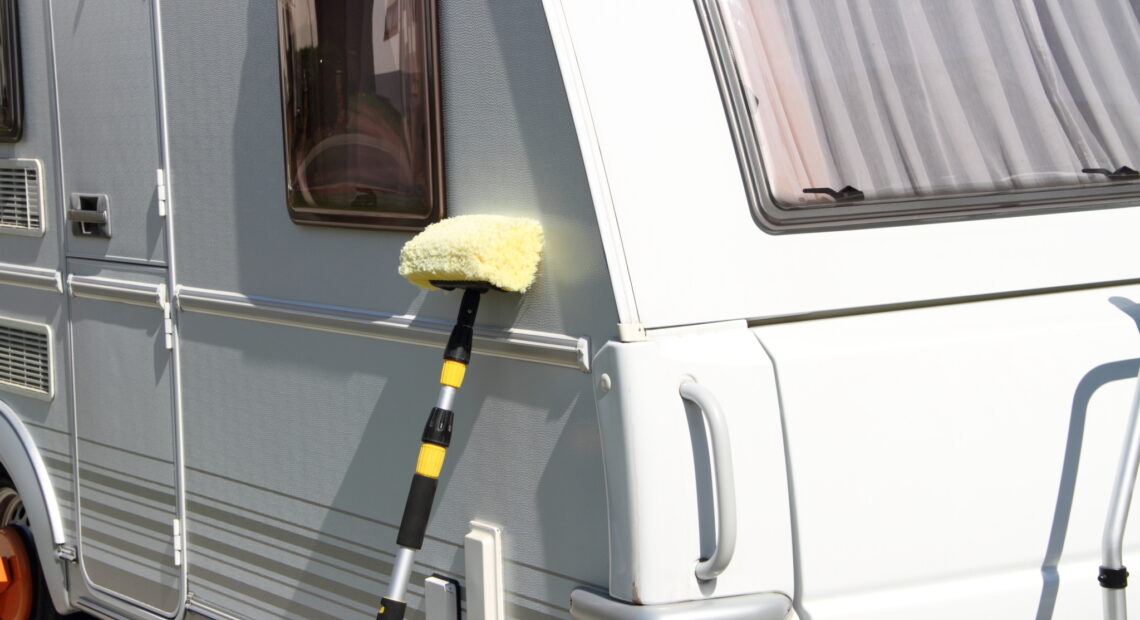The sense of freedom and the exciting adventure that owning a caravan brings you are second to none – but they don’t come quite for free! Your vehicle will definitely face exposure to the elements (dirt, rain, mud and moisture), so regular cleaning is essential. You’ll not only keep your caravan looking fresh but you’ll prevent long-term damage - and you’ll maintain value. A well looked after caravan lasts longer, smells better and is far more pleasant to use than one where upkeep is treated as an afterthought or an inconvenience. This edition of the Couplands blog talks about the routine of properly cleaning your caravan, from the roof to the undercarriage, and includes some great tips!
Why Cleaning Your Caravan Matters
Caravans endure a lot. They go on long journeys, they stay in muddy campsites, they face unpredictable weather, not to mention the things like tree sap and bird poo that take their toll on the exterior. The interior can quickly become cluttered and stale if it’s not regularly looked after (just like you would back at home). Cleaning helps to prevent the build-up of grime that causes damage over time. Left unchecked, things like moss, mildew and dirt can actively deteriorate seals, lead to leaks and cause the windows to cloud. Being able to use a fresh-smelling, sparkling-clean caravan makes the whole experience much more enjoyable. Additionally, if you plan to sell or part-ex your caravan at some point, a well-kept one will retain value better than one that looks neglected.
Preparing to Clean Your Caravan
Before diving into the cleaning process, it’s really important to gather the right supplies. Just thinking “this’ll do” and using the wrong cleaning products can actually cause more harm than good. Harsh chemicals, for instance, can even strip away protective coatings, or damage the delicate acrylic used for caravan windows. There are certain essential supplies you’ll need.
A soft sponge or microfibre cloth
Caravan-specific cleaning solution (ie. not car shampoo)
Bucket (filled with lukewarm water)
Hose (with adjustable spray nozzle)
Window cleaner designed for acrylic surfaces
Wax or polish
A long-handled soft brush (for hard-to-reach areas)
Step ladder (for roof access)
Park your caravan on a level surface, and ideally in the shade (to prevent the cleaning solution from drying too quickly and leaving streaks and spots). Make sure all of the windows and vents are properly closed, and remove any detachable accessories such as bike racks.
Cleaning The Exterior
Start with the exterior, as this is where the most stubborn dirt and grime are usually found. It’s best to begin at the top of the vehicle and work your way down. Doing it this way, any dirt washed from the roof won’t run down and dirty the areas you’ve already cleaned.
Rinse: Use a hose to rinse off loose dirt, leaves, mud and whatever else. You should avoid using a high-pressure washer, as this can damage seals and force water into joints and openings. If you’re dealing with stubborn dirt, allow the water to soak in for a few minutes before carrying on.
Section by section washing: Be organised and methodical. Divide the caravan into manageable sections and tackle them one at a time, using a soft sponge or a brush with your cleaning solution. Work in straight, even strokes. Avoid circular motions, as these can leave swirl marks. Pay attention to areas of the bodywork where dirt tends to collect (eg. window seals, corners and wheel arches).
Roof: The most neglected part of a caravan is often the roof, but it’s crucial to keep it clean to prevent moss and lichen from building up. This is where your step-ladder comes in useful. Use a long-handled soft brush to reach the roof comfortably, and be cautious not to put too much weight on the roof. Some caravans aren’t designed to support heavy loads. Rinse thoroughly to avoid streaks forming as the water dries.
Wheels and undercarriage: The wheels and undercarriage are continuously exposed to mud and gravel, which can cause corrosion if left untreated. Use a hose to rinse off the wheels, then apply a wheel cleaner. Use a soft brush to scrub the wheels with it, paying attention to the wheel arches and any small crevices where dirt might accumulate. If you notice any signs of rust, treat them promptly using a rust-preventing product.
Windows: Caravan windows are usually made from acrylic rather than glass, which makes them more susceptible to scratching and clouding. You should be very careful and only use a cleaner specifically designed for acrylic surfaces, applying it with a soft cloth or microfibre towel. Avoid paper towels, as these are more abrasive than you might think and can actually scratch the surface. Spray the cleaner directly onto the cloth rather than the window, to prevent streaking, and carefully wipe down in smooth, even strokes.
Awning: The awning is often overlooked when it comes to cleaning - but a dirty awning can quickly become home to mildew and unpleasant odours. Unroll the awning fully and brush off loose dirt and debris, then use a mild soap solution and a soft brush to clean the fabric. Don’t scrub too hard, as doing so can damage the waterproof coating of the awning. Rinse it down thoroughly with a hose and let it dry completely before retracting. If you don’t let it dry then moisture will be trapped and can lead to mould.
Cleaning The Interior of Your Caravan
Now that the exterior is sparkling, it’s time for a break before you tackle the inside… Once you’ve finished your brew, gather your cleaning gear and get cracking.
Vacuuming: Start by vacuuming the floors, upholstery and any soft furnishings. Use a soft brush attachment on your vacuum cleaner to do the curtains and blinds, and don’t forget to do inside storage compartments, as dust and crumbs tend to collect there.
Surfaces: Use a mild antibacterial cleaner to wipe down all hard surfaces, including countertops, tables and cupboard doors. Pay extra attention to the kitchen area and bathroom, as these are areas where grease and grime often build up.
Bathroom: Use a specialist bathroom cleaner for the toilet and shower, avoiding anything abrasive that could damage the surfaces. Clean the taps and shower head with a limescale remover if that’s needed.
Upholstery and mattresses: Soft furnishings can trap odours and dust. Remove the cushions and mattress covers and wash them by the manufacturer’s instructions. You can even sprinkle baking soda over mattresses as this is great for absorbing odours. Leave it for about 15 minutes, then vacuum it. Let the cushions and mattresses air out in the sun as this is a good way to freshen them naturally.
Water system: Stagnant water in the caravan’s system can lead to bacteria and unpleasant smells. Drain it completely, and run a caravan-safe sterilising solution through all the pipes and taps. Flush the system with clean water until there’s no trace of the cleaning product left.
Finishing touches: Once everything is clean and dry, apply a protective wax or polish to the exterior of the caravan. This will help to repel dirt and water, making future cleaning easier. Use a soft cloth to apply the polish and buff it to a shine. Don’t forget to lubricate door hinges, locks, and window seals with a silicone spray as this will assist in keeping them in good working order.
To keep your caravan in top condition, aim to give it a quick clean after each trip and do a deep clean at least once a season. This regular upkeep will prevent dirt and damage from accumulating, and keep your caravan looking and feeling like new. Although cleaning your caravan properly may seem like a bit of a chore, the rewards are worth it. A well-maintained caravan looks better, lasts longer and provides a more comfortable and hygienic environment. There’s nothing quite as satisfying as standing back once you’ve given it a thorough going over, and admiring your gleaming home on wheels!
Check the fantastic caravans in stock now, here at Couplands.

